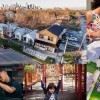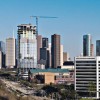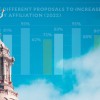
10 in 2023: Top stories from the Urban Edge
Housing costs, the economy, increasing demands on income and concerns about the environment weighed on the minds of Urban Edge readers in 2023.

10 in 2023: Top stories from the Urban Edge
Housing costs, the economy, increasing demands on income and concerns about the environment weighed on the minds of Urban Edge readers in 2023.

Migrants from other states more likely to call Texas their new home
In 2022, millions of Americans were on the move from one state to another. According to the U.S. Census Bureau, Texas was the top destination in the country.

Census director Santos emphasizes community engagement as key to an inclusive count
Seeking unique perspectives and insights can equip the U.S. Census Bureau to reach historically undercounted populations, Director Robert L. Santos said at the Kinder Institute Forum on Wednesday at the Museum of Fine Arts, Houston.

Kinder Institute Forum: Robert L. Santos
Robert L. Santos, director of the U.S. Census Bureau, will discuss leveraging data to advance equity and diversity, lessons learned from the 2020 census, and plans to reach historically undercounted communities in 2030.

United Way data shows where Houstonians are struggling to make ends meet
According to the United Way of Greater Houston, more than 1 million households in the Greater Houston area are considered asset-limited, income-constrained and employed (ALICE) or are below the federal poverty level. These households — as many as 8 in 10 in some neighborhoods — are unable to afford basic necessities.

With economic concerns rising, Houstonians want more done to address the gap between rich and poor
As economic aftershocks from the COVID-19 pandemic linger, Houstonians have a dimmer view of their prospects, according to the 42nd annual Kinder Houston Area Survey. With inflation and housing costs reaching record highs—and a potential recession on the horizon—optimism among survey respondents was at one of its lowest levels in nearly three decades. More than ever before, Houston residents are also in alignment that more must be done to close income gaps.

Kinder Houston Area Survey: 2023 Results
The 42nd Kinder Houston Area Survey provides a glimpse into how Houstonians are thinking about the economy, affordable housing, inequality, and other critical challenges and issues facing their communities.

Kinder Institute Luncheon 2023
The annual luncheon brings together hundreds of business, nonprofit and community leaders to learn about the leading issues facing our community and country.

Harris County bounces back in a big way in 2022 population estimate
Harris County’s population growth has found renewed vigor after a year of stagnation, according to new Census estimates released today, but these gains were far overshadowed by more rapid suburban growth.

As part of a wide range of testimony before the state Senate finance committee, education commissioner Mike Morath told lawmakers that Texas is entering a new demographic era for public school enrollment.

Fort Bend County found to be among the nation’s most prosperous for immigrants
In the past decade, immigrant populations fueled immense population growth in cities and suburbs in particular, according to a new report by the George W. Bush Institute. In the Houston metropolitan area, the report finds that immigrants are thriving best in Fort Bend County, ranked No. 8 in the country, and Brazoria County, ranked No. 15. Harris County was ranked No. 99.

After Census redefines urban and rural, Texas remains steadfastly both
The number of people in the U.S. who live in an urban setting has grown by 6.4%, according to new 2020 Census data. But the nation's overall percentage of urban area population was slightly reduced after the U.S. Census Bureau altered the criteria for what is considered an urban or rural area.

'The New Red Book' is a call to appreciate Houston as a bastion of Black heritage
A new book serves as a long overdue field guide to Black history in Houston, one that hearkens back to a century-old catalog of the city’s African American community. In “The New Red Book,” author Lindsay Gary takes readers to 50 sites, telling the stories about these important spaces and the people whose legacies remain relevant today.

Houston Community Data Connections
An interactive data platform, this initiative seeks to facilitate the practical use of data by city and community leaders for decision-making and capacity building in Houston's communities.

Where Houstonians stand on education, CRT, abortion rights, and voter access in 2022
If you built a political platform based on what most Houstonians would agree with, what would it look like? We have one version of a “Houston agenda”, thanks to the 2022 Kinder Houston Area Survey. While divisions persist, big shares of Houstonians across party lines agree on several big issues.
Rice University
Kraft Hall
6100 Main Street, Suite 305
Houston, TX 77005-1892